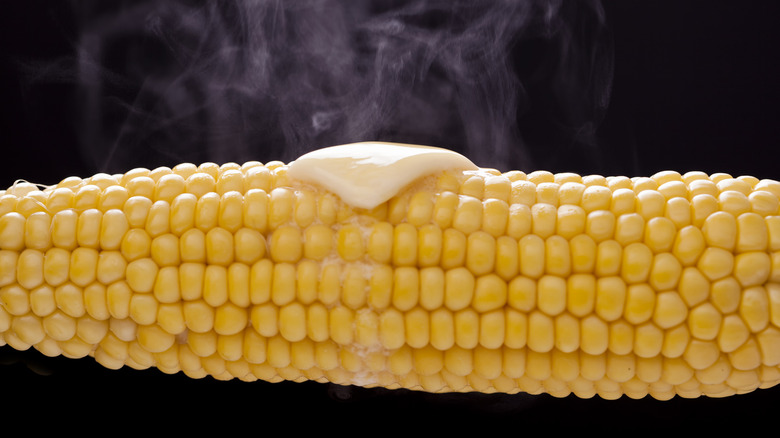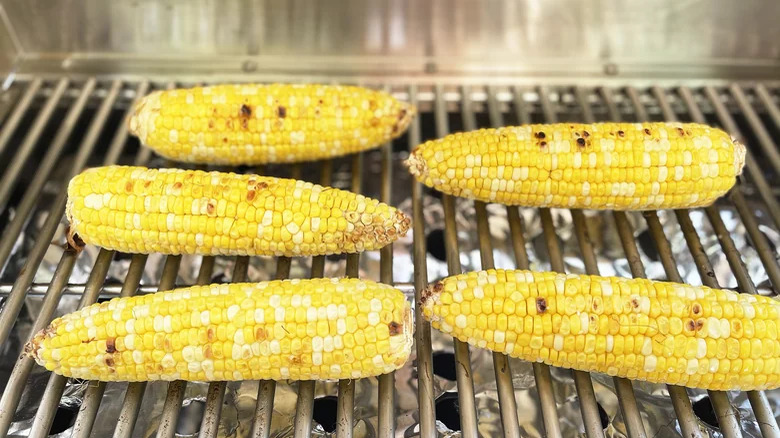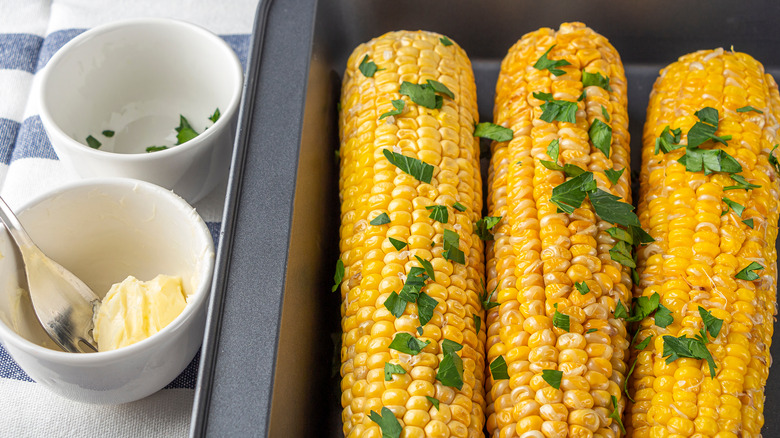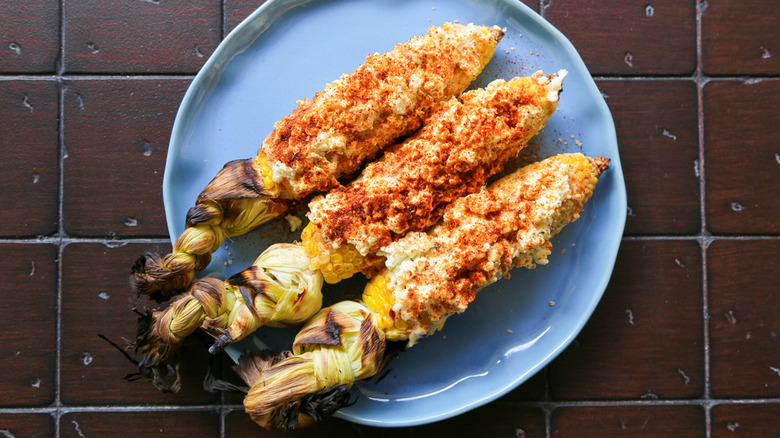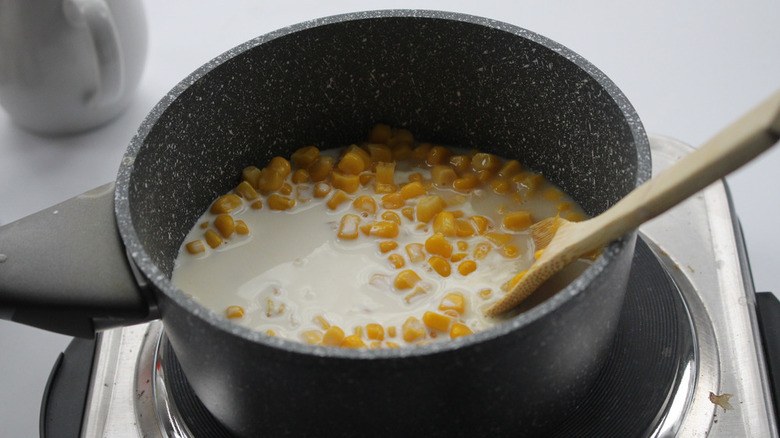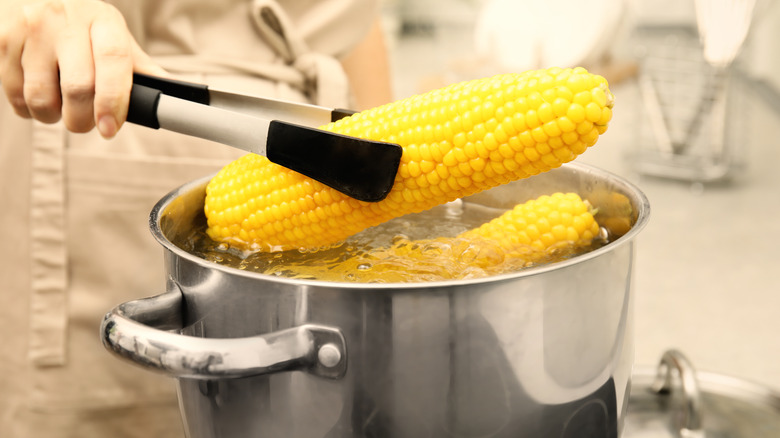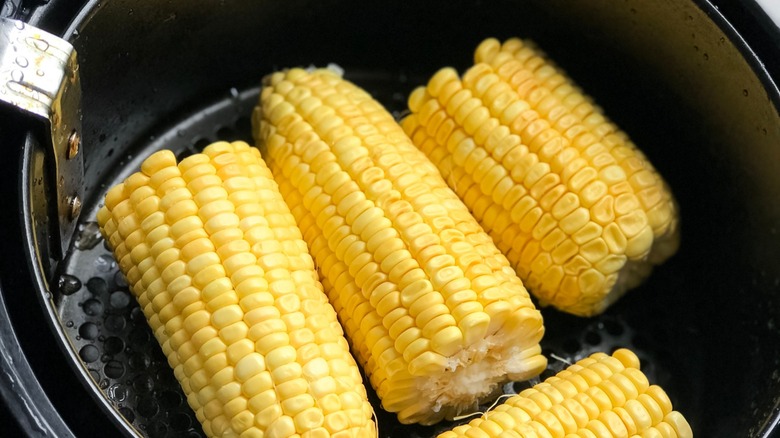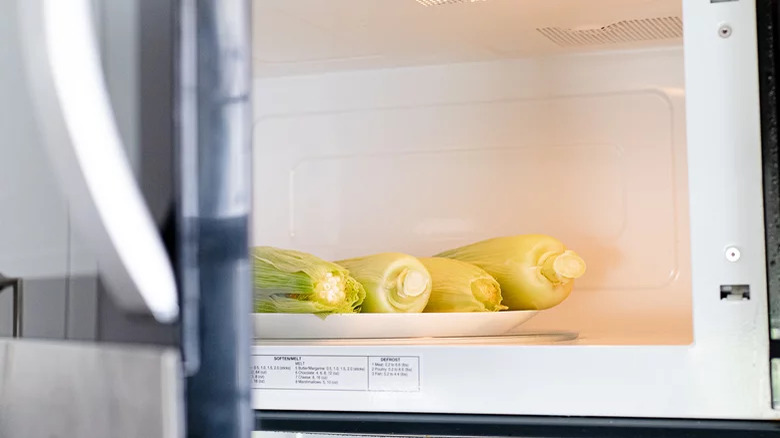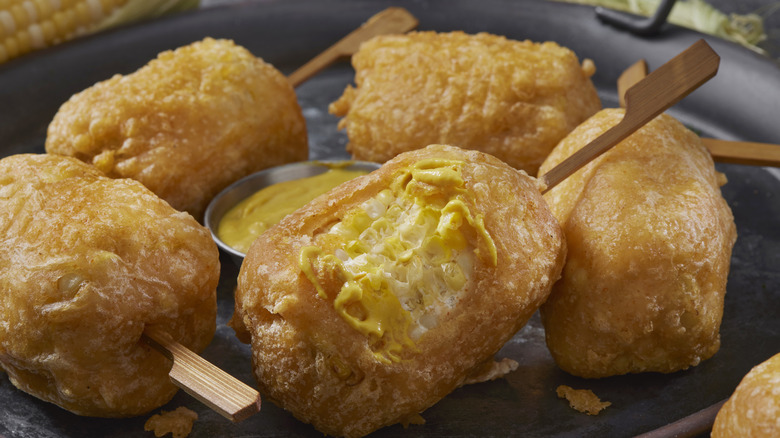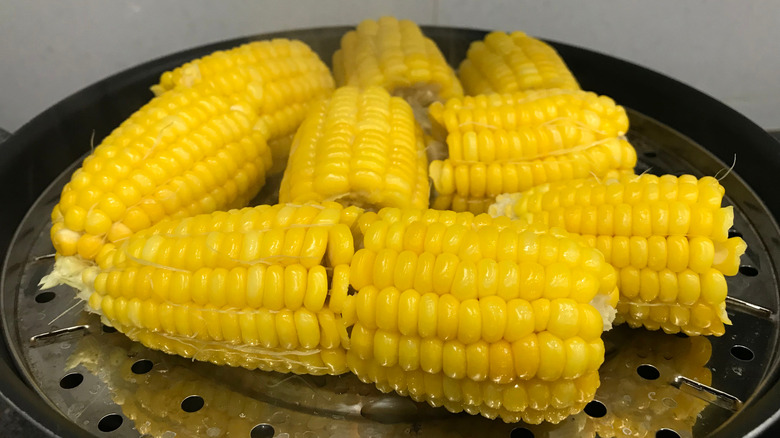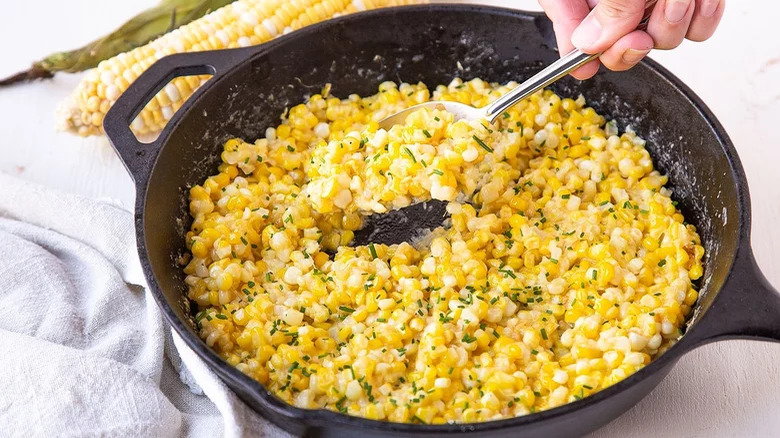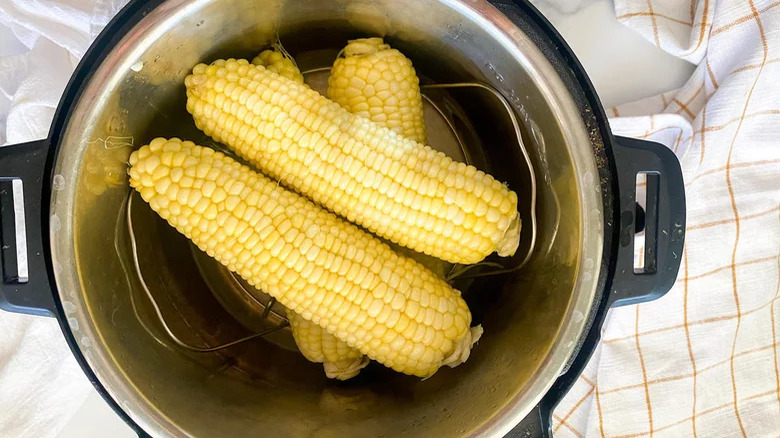The Best Ways To Reheat Corn On The Cob
Is there anything as simple and spectacular as sinking your teeth into a hot, buttery corn on the cob? You can even get little forks to stick in either end that act as handles, too, so that you can gnaw your way around the cob and enjoy every last kernel. Corn isn't only delicious, but it's also high in fiber. Although, it's definitely starchy which might not be ideal if you're watching your blood sugar levels. Whether you've got some frozen cooked cobs in the freezer or some leftover ears of corn that are already cooked, you can always store them in the refrigerator.
Not only do they taste great reheated, but this ensures that cobs that have been previously cooked and chilled are safer to eat, too. Make sure you don't overheat them, though, or they'll lose all their goodness and taste tough. You can keep the corn cobs in the fridge for a few days. What everyone loves about this vegetable is that you can use it to make main meals, snacks, sides, and even some desserts. If you've got some chilled cobs that you want to revive, then check out these methods for reheating corn on the cob. They are all super-easy and quick, and which one you choose may depend on how you want your corn to taste and what kind of dish you intend it for.
On a grill
When it's cookout time, prepping ahead of time is essential, especially if there are a lot of mouths to feed. This could entail cooking the corn beforehand or buying pre-cooked cobs. Either way, you can easily reheat them on the grill so that they get that lovely, charred look and smoky taste. Consider lowering cooking time for grilled corn on the cob that's already undergone some prior heating. Sprinkle with salt and rub with unsalted butter before charring. Grilled corn kernels are tasty on a salad or in a burrito bowl or mixed with creamy Cotija cheese.
You can also brush the cooked cobs with oil and turn them so that they reheat properly. Grilling gives corn a smoky, sweet taste and even if you've roasted them before, you can always heat them up again the same way. If the husks are still attached, pull them back and submerge them in water for 20 minutes to stop them from setting alight on the grill. If you are concerned about the corn drying out, then wrap the ears in foil. A suggestion: Rub the cobs with oil, season them with salt and pepper, and add some knobs of butter on top of your corn cobs before the foil wrapping. You'll also want to pierce the foil in a few places so that the steam can escape. The foil wrap keeps the corn juicier, although it won't have the same charred taste.
In an oven
One of the best ways to reheat corn on the cob, no matter how you cooked it the first time, is in the oven. The beauty of this method is that it promises to heat the whole ear evenly, so you're not likely to bite into a red-hot kernel followed by a spot that's stone cold. Put the cobs in an oven tray, add a couple of tablespoons of water, and then cover with foil. Cook for 5 minutes at 400 Fahrenheit. That's it. Add your butter and any seasonings when serving.
You can lower the temperature and extend the reheating time a little, too. Another oven method is wrapping the ears of corn in foil individually with some water and butter and season them with salt and pepper first. You can add milk instead of water, too, and to keep the heat in, secure the foil at the ends of each cob by twisting. Don't make it too tight, though; although you want the moisture to stay in, you'll also want to open the foil package so you can check the cobs. The best way to know when they are done is to feel how hot the kernels are. For a flavor boost, mix hot sauce with melted butter to flavor the cobs before reheating.
Under a broiler
If you don't really want to heat up your oven for a few ears of corn, use your broiler instead. The direct heat brings out the flavor of the vegetable as it warms, and there are a few different approaches to this method. If your broiler is in your oven, then you might have to adjust the shelf height so that the cobs are around six inches from the grill. Place them on a wire tray and turn them a little as they get hot so they heat evenly. You can add toppings, too, such as cheese, or seasonings such as garlic powder and onion powder. Add a baking tray underneath for any drips.
If you feel like getting fancy, tie the pulled-back husks into braids, rub the corn with butter, and broil on a baking tray. Once the cobs are hot and some of the kernels are nicely browned, slather with mayonnaise, dip in Cotija cheese, and sprinkle on a good amount of taco seasoning. Use the braided husks to hold the corn and eat this messy, juicy street-style snack. Greek yogurt is a wonderfully creamy topping to add to reheated corn, too; cheese-wise, you can add some tang with grated cheddar or Parmesan.
On a stovetop
If your corn on the cobs are already cooked, then you could use a sharp knife to remove the kernels and reheat the pieces rather than the whole ear of corn. To take off the kernels, place a small bowl upside-down inside a larger one. Stand an ear of corn up on the base of the upturned bowl, with the thicker end turned down in the bowl. Hold the tip of the cob and cut in downward strokes. The bigger bowl will catch all the kernels. In Thailand, a popular street food snack is cooked kernels mixed in a saucepan with a little butter, condensed milk, and sugar served in a cup with a spoon. It turns sweetcorn into a dessert.
Another dish that's kind of like this and popular in the U.S. is creamed corn. It's also sweet but makes a great savory side with some grilled meat. Add ground black pepper and some spices to lift the flavor. Heat the kernels in a saucepan and add light cream and milk. Get the temperature up a little before adding sugar, cornstarch, and vanilla extract, plus some salt. You want the corn mix to thicken, but not to the point where it's dry.
In boiling water
Cooked corn on the cob often comes frozen, and one way to reheat it is in boiling water. To do this, put the corn in a stovetop pot full of water and heat. When the water boils, cover the pot, and turn the heat down while the cobs warm up in a matter of minutes. Before eating, put a corn ear in a bag with canola oil and spices. Seal the bag and shake it so that the whole cob is covered with the oily seasoning. You can also remove the reheated kernels and add these to the spiced oil.
If your pot is too small, cut the cobs in halves or thirds so that they fit. Rather than adding a pinch of salt to the boiling water as you might with other veggies to bring out the savory flavor, add a little sugar instead. This enhances the sweetness and works for corn that was cooked in boiling water or streamed the first time. You probably wouldn't want to add sugar to a cob that's been baked or grilled and buttered the first time around.
In an air fryer
Your air fryer is a great way to cook whole recipes from scratch in a way that's healthier than frying. It's also a handy countertop appliance for reheating many foods, including corn on the cobs. If the corn was roasted in the oven previously or cooked on the grill, then an air fryer is ideal for reheating it. The same goes for corn that's been cooked in boiling water or steamed.
Add a pat of butter and some seasonings while the ears of corn are in the air fryer. The fat will lock in the moisture, and when the kernels become hot again, the flavor will get a boost. Wrap the cobs in foil before placing them in the tray and add a little water along with the butter. You can also put some fresh parsley and sea salt into melted butter and brush it onto your corn before heating.
In a microwave
If you are an old hand in the kitchen or a foodie, you may balk at the idea of cooking in a microwave. If so, that's your call, but microwaves are mighty handy machines for quickly reheating cooked food. They are efficient, effective, and easy to use. They also help keep other appliances free, which is useful if you're at maximum capacity cooking a full-on dinner for guests with multiple courses. You still need to keep an eye on the corn, though, as it's super easy for anything in a microwave to swiftly go from not quite done to overdone.
Put your cooked corn in a microwavable dish and add a little water to the bottom. Instead of a lid, place a damp towel over the top to create a steamy environment. That way, the kernels won't dry out. Turn the cobs to heat evenly. If your corn hasn't been previously cooked, you can even cook microwave corn on the cob. To do this, trim and take off the outer layers of the husk but keep most of this intact as it aids the cooking process. Flip once during the cooking time, and let the ears cool out of the microwave — they will continue to cook at the same time. All that's needed to appreciate each cob is a pat of butter, black pepper, and some fine sea salt. Minced basil can add an herby taste, too.
Deep frying
It's arguable that almost any food that's deep fried is intrinsically tasty. So it's no surprise that Southern-style spicy breaded corn on the cob plunged into hot fat is no exception. You can use fresh corn or defrosted frozen cobs. Cajun seasonings in cornmeal add flavor to corn softened in a buttermilk soak. You can also add some Parmesan into the coating or change up the seasonings, and baking powder gives the exterior some extra crispiness. Make sure the corn is nice and dry before frying and don't heat the oil at too high a temperature, keep it at a medium heat.
Add sticks to cut-up cobs before battering and frying and serve with whatever dip you like, such as spicy mustard. You can also try thawing corn and turning it into a panko-encrusted, deep-fried bite, serving it with cheese, mayo, and butter, with cayenne pepper and lime juice.
In a steamer
One of the best ways to cook corn on the cob is to steam it. The moisture makes the kernels nice and juicy rather than shriveled up. Steamed corn also maintains some crunch to them, too, while bringing the sweetness to the forefront. Don't lift the lid too much to check whether the cobs are ready, as this will let out too much heat. Meanwhile, a good way to fit more corn in your steamer is to cut the corn ears in half so you can move them about and create more space.
When steaming, avoid adding salt to the corn or the water underneath the steamer. You can add salt once the corn is ready to serve so that the kernels have a softer texture. Keep an eye on the water level, too. You don't want it so high that it bubbles over or through the steamer, but you don't want it to run dry, either. Steaming is not only an easy way to heat corn, but unlike boiling, you're retaining a lot more nutrients. A useful utensil for putting the corn ears in the steamer and taking them out is a pair of tongs.
By frying
As well as steaming, boiling, and deep frying, you can also grab a frying pan to reheat cooked corn. It's not as greasy as plunging the corn into a vat of oil, and still has the umami appeal that comes with frying food. If you want to reheat your corn and put a Southern spin on it, you can start by frying the corn in butter and bacon grease and use salt and sugar to balance the sweet and savory taste. Mix in flour to thicken the consistency, as this gives the dish a creamy quality without needing to add any dairy ingredients. Sprinkle with chopped chives when it's done. This makes a yummy side to roast or fried chicken.
Heading even further south, elote is another Mexican street food made from corn on the cobs that lends itself to corn reheated in a frying pan. You can make this dish using cooked kernels in individual servings in a cup, too, which is perfect for parties. Top a spoonful of the corn with lime juice, butter, crema Mexicana, and chili powder, plus cotija cheese and hot sauce. The taste is fresh, sweet, tangy, and spicy.
In an Instant Pot
You might think of your Instant Pot as a slow cooker for stews and casseroles. However, it's one of the best ways to reheat corn on the cob, too. Put the cooked corn ears onto the rack or Instant Pot steamer basket and also put a cup of water in the bottom. Heat for a couple of minutes under high pressure and quick release the steam before serving. You can always place the cobs in a bowl with just a little water and heat them up in the Instant Pot for less than a minute at a time until the kernels are hot enough. There are many strategies for making Mexican street corn that specifically calls for use of an Instant Pot, as well as the so-called low country boil. One thing that's great about corn is it works as a side for many, many entrées from all kinds of different culinary traditions. If you've got some leftover corn on the cob, you won't be lacking for good ideas on how to put it to use.
